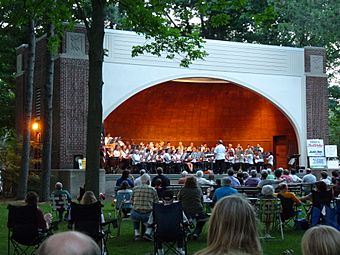Columbia Park Band Shell facts for kids
Quick facts for kids |
|
|
Columbia Park Band Shell
|
|
 |
|
| Location | 201 W. Arnold St., Marshfield, Wisconsin |
|---|---|
| Area | less than one acre |
| Built | 1931 |
| Built by | Frank A. Felhofer |
| Architect | G.A. Krasin |
| Architectural style | Art deco |
| NRHP reference No. | 08000842 |
| Added to NRHP | September 3, 2008 |
The Columbia Park Band Shell is a special outdoor stage in Marshfield, Wisconsin. It's located right near the railroad tracks. This band shell was built in 1931. It was a project to help people find jobs during a tough time called the Great Depression.
Even today, the band shell hosts free summer concerts every week. It's a fun place for the community to gather. Because of its history and importance, the band shell was added to the National Register of Historic Places in 2008.
Contents
A Park's Early Days
The land where the band shell stands today was given to Marshfield in 1875. Samuel Marsh donated it so the city could create a park. For many years, the land wasn't used much.
In the 1890s, more people started moving to the area. Farmers settled on newly cleared land. Factories also opened, bringing more workers. As the town grew, it needed a central water supply. So, a tall, 120-foot steel standpipe was built in the middle of the park.
First Bandstand in the Park
In 1903, a wooden bandstand was built in the park. This was a Victorian-style building. It became the home for summer concerts by Marshfield's 135th Medical Regiment Band. This band was very popular. They played twelve concerts every summer.
Building the New Band Shell
By 1926, the old wooden bandstand was not safe. City engineers said it needed to be torn down. So, the summer concerts continued, but the band played on the lawn.
In 1929, the country faced a big economic crisis called the Wall Street Crash. This made it hard to get money for new projects. Plans for a new band shell stopped for a while.
A Project for Jobs
Finally, in 1931, construction began on the new brick band shell. City leaders decided to build it as a public works project. This meant it was a government-funded project designed to create jobs. It helped local men who had lost their jobs during the Depression.
The Marshfield Brick Company also helped. They sold bricks for the project at a much lower price. This made it easier to build the band shell.
Cool Design and Sound
The new band shell had a special dome-shaped ceiling. This idea came from indoor theaters. It helped the sound travel better and louder. This improved acoustics meant the band could play more types of music. They could play softer, more detailed songs, not just loud marches.
The outside of the band shell is made of horizontal bricks. It has a strong concrete foundation. Two tall brick columns, called pilasters, frame the stage. These columns have stone panels carved with trumpets and drums. Inside, the shell is made of cedar and redwood. It also has storage rooms and restrooms.
A Lasting Legacy
The first concert at the new band shell in 1931 was a huge success. Over 3,000 people from the community came to listen. The band played marches and lighter songs, like music from "The Barber of Seville."
A local newspaper wrote that people need more than just food to live. They said the free band concerts gave people something important. These concerts offered free fun and a break from the worries of daily life during the Depression.
The band shell has been used for more than just music. In 1932, about 6,000 local farmers gathered there. They were part of a nationwide strike. They wanted better prices for their crops.
Images for kids




